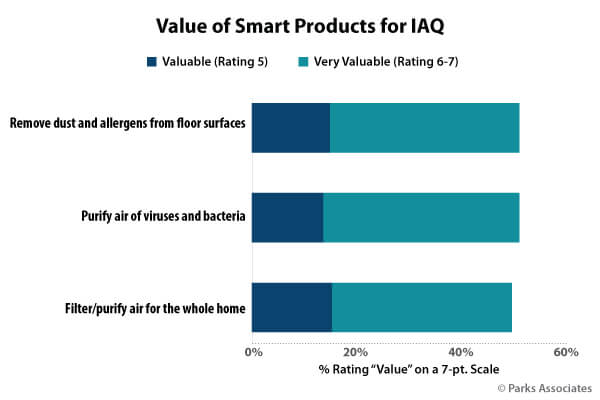following COVID, more people are interested in their indoor air quality.
As a result of COVID-19, the demand for healthy homes and superior air quality has exploded. Now that there is a new awareness of health and wellness, clean air is vital to overall home health. Internationally recognized research firm Parks Associates found that almost 50% of US broadband households have a health condition sensitive to IAQ (indoor air quality). Additionally, the firm’s latest research reveals that 34% of US broadband households are concerned about IAQ.
Smart home technology began as a way to upgrade the running of households, with the IoT telling one device how to operate another without human contact required. However, in an age when technology can reduce the need to touch surfaces—and therefore the risk of infection—contactless living has become a serious consideration for consumers.
Although the rise in adoption of smart home devices has been slow, consumers have embraced smart home technologies and connectivity in the home. Currently, more than one-third of U.S. broadband households now own a smart home device, up from 29% in Q4 2019. Parks Associates found that this growth comes not only from the expanding number of households buying their first smart home product, but also an expansion in the range of smart products available.
As consumers continue to spend most of their time indoors, concerns around IAQ and health have become particularly important. Parks Associates reveals that 1 in 5 consumers are very concerned about the air quality in their homes.
It is widely known that extended exposure to air pollutants can enhance the risk of respiratory diseases and poor air quality can been linked to a wide variety of health-related effects such as headaches, difficulty sleeping, dizziness, and respiratory conditions. Additionally, 37% of broadband households are concerned about dust and allergens inside their homes.
Although an increase in pollen and allergens outside tend to keep those with allergies indoors, these substances can be found indoors too. One in four broadband households are concerned about viruses and bacteria, and Parks Associates’ latest research shows that over 50% of US broadband households find a smart product that removes dust/allergens from the floor and purifies the air of viruses and bacteria as valuable. This has been accelerated with COVID-19 and the need for superior ventilation and improved IAQ can be effective in reducing airborne virus transmissions.

COVID-19 has shed new light on the impact of poor air quality and the need for proper ventilation. Improving awareness and familiarity of IAQ beyond those with health conditions will help improve adoption. Twenty percent of consumers are highly concerned about air quality, and ~20% own a smart climate control device. This illustrates that ownership is driven by those highly invested in indoor air quality. In order to reach mass-market adoption, awareness of both IAQ problems as well as solutions must grow and prices will need to drop to become more affordable to the average consumer.
Parks Associates new consumer report
Fresh Air: Air Quality and Comfort in the Smart Home quantifies consumer concerns about indoor air quality (IAQ) and value perceptions, ownership, and purchase intentions for related solutions and services, including smart fans, smart vents, air filtration, ventilation systems, and more.
For more information about this research or Parks Associates, please visit
www.ParksAssociates.com